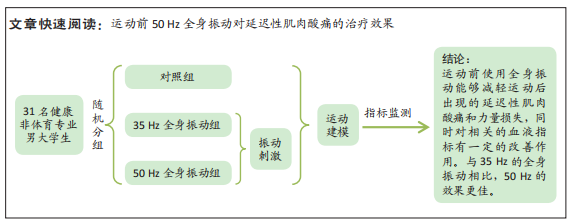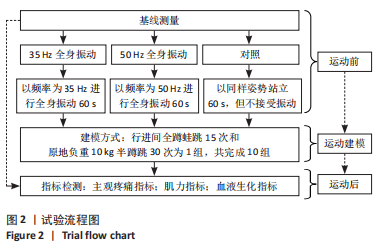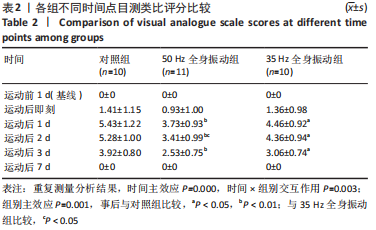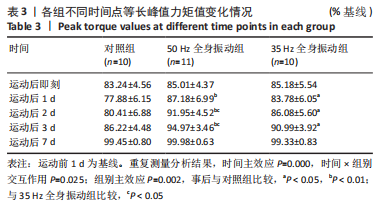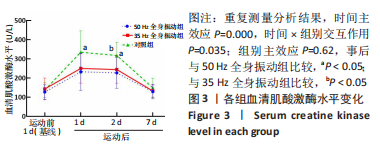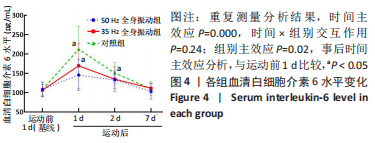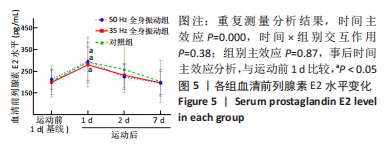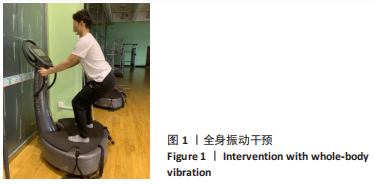[1] PRIEGO-QUESADA JI, DE LA FUENTE C, KUNZLER MR, et al. Relationship between Skin Temperature, Electrical Manifestations of Muscle Fatigue, and Exercise-Induced Delayed Onset Muscle Soreness for Dynamic Contractions: A Preliminary Study. Int J Environ Res Public Health. 2020; 17(18):6817.
[2] 汪军, 周越, 孙君志, 等. 质疑与思考:运动生理学研究的十个问题[J]. 成都体育学院学报,2021,47(1):118-124.
[3] 张国海, 王人卫. 肌内效贴对延迟性肌肉酸痛和肌肉功能恢复的影响[J]. 体育科学,2017,37(12):46-51.
[4] MUELLER-WOHLFAHRT H, HAENSEL L, MITHOEFER K, et al. Terminology and classification of muscle injuries in sport: The Munich consensus statement. Br J Sports Med. 2013;47(6):342-350.
[5] WUESTEFELD A, FUERMAIER ABM, BERNARDO-FILHO M, et al. Towards reporting guidelines of research using whole-body vibration as training or treatment regimen in human subjects—A Delphi consensus study. PLOS ONE. 2020;15(7):e235905.
[6] AMINIAN-FAR A, HADIAN M, OLYAEI G, et al. Whole-body vibration and the prevention and treatment of delayed-onset muscle soreness. J Athl Train. 2011;46(1):43-49.
[7] MAGOFFIN RD, PARCELL AC, HYLDAHL RD, et al. Whole-Body Vibration as a Warm-up Before Exercise-Induced Muscle Damage on Symptoms of Delayed-Onset Muscle Soreness in Trained Subjects. J Strength Cond Res. 2020;34(4):1123-1132.
[8] TAN J, SHI X, WITCHALLS J, et al. Effects of Pre-exercise Acute Vibration Training on Symptoms of Exercise-Induced Muscle Damage. J Strength Cond Res. 2022;36(8):2339-2348.
[9] 钟国友. 振动刺激附加肌内效贴治疗运动性膝关节延迟性肌肉酸痛[J]. 中国组织工程研究,2019,23(27):4305-4309.
[10] 邱俊强, 耿国强, 潘阳梦柔. 支链氨基酸联合葡萄糖补充时机对大强度离心运动后延迟性肌肉酸痛及相关指标的影响[J]. 中国体育科技,2019,55(3):66-72.
[11] 邹亮畴. 非极限负荷气动变阻力量训练效果比较分析[C].广东省体育科学学会第二届体育科学大会, 中国广东广州,2007.
[12] VAN MELICK N, MEDDELER BM, HOOGEBOOM TJ, et al. How to determine leg dominance: The agreement between self-reported and observed performance in healthy adults. PLOS ONE. 2017;12(12): e189876.
[13] HOHENAUER E, COSTELLO JT, DELIENS T, et al. Partial‐body cryotherapy (−135°C) and cold‐water immersion (10°C) after muscle damage in females. Scand J Med Sci Sports. 2020;30(3):485-495.
[14] KOCH AJ, PEREIRA R, MACHADO M. The creatine kinase response to resistance exercise. J Musculoskelet Neuronal Interact. 2014;14(1): 68-77.
[15] DOS SANTOS RS, VERAS FP, FERREIRA DW, et al. Involvement of the Hsp70/TLR4/IL‐6 and TNF‐α pathways in delayed‐onset muscle soreness. J Neurochem. 2020;155(1):29-44.
[16] 王今越, 丁树哲, 刘伟, 等. 运动与IL-6的研究进展[J]. 体育科学, 2007(6):60-69.
[17] OTA H, KATANOSAKA K, MURASE S, et al. EP2 receptor plays pivotal roles in generating mechanical hyperalgesia after lengthening contractions. Scand J Med Sci Sports. 2018;28(3):826-833.
[18] Rondanelli M, Fossari F, Vecchio V, et al. Clinical trials on pain lowering effect of ginger: A narrative review. Phytother Res. 2020;34(11):2843-2856.
[19] 朱晓凤. 不同频率全身振动训练对老年人平衡和核心稳定性的影响[J]. 中国康复理论与实践,2020,26(3):291-294.
[20] PARADISIS GP, PAPPAS P, DALLAS G, et al. Acute Effects of Whole-Body Vibration Warm-up on Leg and Vertical Stiffness During Running. J Strength Cond Res. 2021;35(9):2433-2438.
[21] CARDINALE M, BOSCO C. The use of vibration as an exercise intervention. Exerc Sport Sci Rev. 2003;31(1):3-7.
[22] REHN B, LIDSTROM J, SKOGLUND J, et al. Effects on leg muscular performance from whole-body vibration exercise: a systematic review. Scand J Med Sci Sports. 2007;17(1):2-11.
[23] 许智勇, 殷鑫, 黄强年, 等. 离心运动的特征和急性反应[J]. 中国组织工程研究,2018,22(16):2607-2612.
[24] HOTFIEL T, FREIWALD J, HOPPE MW, et al. Advances in Delayed-Onset Muscle Soreness (DOMS): Part I: Pathogenesis and Diagnostics. Sportverletz Sportschaden. 2018;32(4):243-250.
[25] LAU WY, NOSAKA K. Effect of vibration treatment on symptoms associated with eccentric exercise-induced muscle damage. Am J Phys Med Rehabil. 2011;90(8):648-657.
[26] 李玉章. 全身振动训练的理论与实践[M]. 上海:第二军医大学出版社,2010.
[27] KERSCHAN-SCHINDL K, GRAMPP S, HENK C, et al. Whole-body vibration exercise leads to alterations in muscle blood volume. Clin Physiol. 2001;21(3):377-382.
[28] SA-CAPUTO D, PAINEIRAS-DOMINGOS L, CARVALHO-LIMA R, et al. Potential effects of whole-body vibration exercises on blood flow kinetics of different populations: a systematic review with a suitable approach. Afr J Tradit Complement Altern Med. 2017;14(4 Suppl): 41-51.
[29] SOUZA-SILVA E, CHRISTENSEN SW, HIRATA RP, et al. Blood flow after contraction and cuff occlusion is reduced in subjects with muscle soreness after eccentric exercise. Scand J Med Sci Sports. 2018;28(1): 29-39.
[30] 宋法明, 刘北湘. 全身振动介入静态伸展对离心运动后延迟性肌肉酸痛的影响研究[J]. 山东体育学院学报,2017,33(1):74-79.
[31] 袁艳, 吴贻刚, 苏彦炬, 等. 振动频率和负荷重量对半蹲起大腿肌群表面肌电活动的影响[J]. 体育科学,2012,32(10):64-68.
[32] RONNESTAD BR, ELLEFSEN S. The effects of adding different whole-body vibration frequencies to preconditioning exercise on subsequent sprint performance. J Strength Cond Res. 2011;25(12):3306-3310.
[33] TURNER AP, SANDERSON MF, ATTWOOD LA. The Acute Effect of Different Frequencies of Whole-Body Vibration on Countermovement Jump Performance. J Strength Cond Res. 2011;25(6):1592-1597.
[34] ABERCROMBY AF, AMONETTE WE, LAYNE CS, et al. Variation in neuromuscular responses during acute whole-body vibration exercise. Med Sci Sports Exerc. 2007;39(9):1642-1650.
[35] 刘北湘, 刘晓亚, 戴玮. 振动频率影响肌肉力量振动训练效果的实验研究[J]. 成都体育学院学报,2016,42(3):111-115.
|
